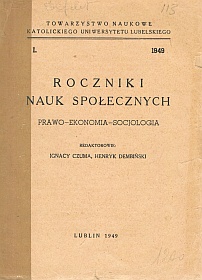Charakter prawny przestrzeni powietrznej
Abstrakt
The aerial space was always the object of private rights. The public law had to deal with it since the wires of electric energy in all its forms had to be drawn through the air with no regard to the possible opposition of the land-owners concerned. The problem, however, appeared in a new light with the rise and development of air transport. Despite the attempts to proclaim the atmosphere as free as the high sea, the first international aerial convention of 1919 made it an object of sovereign rights of the states.
The author, however, does not share the view that those rights bear by themselves any restriction to the private ones and that the air as such is a public good. This view, at any rate, can not be maintained with regard to Polish laws. According to the latter a thing (like waters or public roads) is a public good destined for public use, not by its nature but only by an express provision of the law. The fact that the air, according to the law, is open for aerial transport does not abolish the private rights due to the landowners concerned and expressly recognised by the Polish civil law.
Copyright (c) 1949 Roczniki Nauk Społecznych

Utwór dostępny jest na licencji Creative Commons Uznanie autorstwa – Użycie niekomercyjne – Bez utworów zależnych 4.0 Międzynarodowe.


